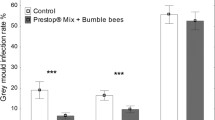Abstract
Lepidopteran stem borers account for heavy losses in cereals in areas where they are prevalent throughout Africa. Microsporidia, especially Nosema sp. may be developed for use in the management of this group of insect pests. Studies carried out so far show that the application of Nosema spores may increase yield up to 34% in sorghum when the plants are infested with Chilo partellus eggs and sprayed with the pathogen, and up to 80% in sorghum infested with borer larvae.
The procedure for spore production is simple, and may easily be adapted for small scale industrial production by local or regional communities and organizations. In trials aimed at the mass production of Nosema sp. for the management of C. partellus, a yield of 109 spores/larva has been attained. If this production level can be maintained, then a system that produces only 6000 larvae/day would yield enough cadavers for preparation of 6000 l daily. At the rate in which the pathogen suspension is applied as foliar sprays in the field, this would be sufficient to treat 5373 ha. If widely adopted, use of microsporidia would revolutionize cereal stem borer management in the tropics.
Résumé
Les Lépidoptères foreurs de tiges sont responsables des pertes énormes dans la production de mais, sorgho, tef, millet et d’autres céréales dans les régions où ils sont prédominants a travers l’Afrique. Les Microsporidies, particulièrement Nosema sp. peuvent être développées pour la lutte contre les foreurs de tiges. Les études conduites jusqu’à ce jour montrent que l’application des spores de Nosema peut augmenter la production de sorgho jusqu’ à 34%, lorsque les plantes sont infestées avec les pontes de Chilo partellus puis traitées avec le pathogène. L’augmentation de la production est de l’ordre de 80% dans le cas où les plantes sont infestées avec les larves.
Le procédé de production des spores est simple, et peut être facilement adapté pour les petites entreprises par les communautés et organisations régionales. Dans la présente étude, une production de 109 spores/larve a été obtenue. Dans le cas où ce niveau de production peut être maintenu, alors un procédé susceptible de ne produire que 6000 larves par jour, produirait suffisamment de cadavres pour la préparation de 6000 l par jour. A la concentration à laquelle le pathogène est pulvérisé sur le substrat foliaire au champ, il serait possible de traiter 5373 ha. Dans le cas où le concept de lutte biologique est largement adopté, l’emploi des microsporidies pourrait révolutionner la lutte contre les foreurs de tiges.
Similar content being viewed by others
References
Ampofo J. K. O. (1986) Maize stalk borer (Lepidoptera: Pyralidae) damage and plant resistance. Environ. Entomol. 15, 1124–1129.
Andreadis T. G. (1984) Epizootiology of Nosema pyrausta in field population of the European corn borer (Lepidoptera: Pyralidae). Environ. Entomol. 13, 882–887.
Angus T. A. and Luthy P. (1971) Formulation of microbial insecticides. In Microbial Control of Insects and Mites (Edited by Burges H. D. and Hussey N. W.), pp. 623–628. Academic Press, New York, London.
Couch T. L. and Ignoffo C. M. (1981) Formulation of insect pathogens. In Microbial Control of Pests and Plant Diseases 1970–1980 (Edited by Burges H. D.), pp. 621–634. Academic Press, New York, London.
Hill R. E. and Gary W. F. (1979) Effects of the microsporidium Nosema pyrausta on field populations of European corn borers in Nebraska. Environ. Entomol. 8, 91–95.
Hostounsky Z. and Weiser J. (1972) Production of spores of Nosema plodiae Kellen et Lindegren in Mamestra brassicae L. after different infective dosage. Vest. Cs. Spol. Zool. 36, 97–100.
Lewis L. C. (1982) Persistence of Nosema pyrausta and Vairimorpha necatrix measured by microsporidiosis in the European corn borer. J. econ. Entomol. 75, 670–674.
Lewis L. C. and Cossentine J. E. (1986) Season long intraplant epizootics of entomopathogens Beauveria bassiana and Nosema pyrausta in a corn agroecosystem. Entomophaga 31, 363–369.
Lewis L. C. and Lynch R. E. (1978) Foliar application of Nosema pyrausta for suppression of populations of European corn borer. Entomophaga 23, 83–88.
Richter A. R. and Fuxa J. R. (1984) Timing, formulation and persistence of a nuclear polyhedrosis virus and a microsporidian for control of the velvetbean caterpillar (Lepidoptera: Noctuidae) in soybean. J. econ. Entomol. 77, 1299–1306.
Sampson M. A. and Kumar R. (1983) Population dynamics of the stem borer complex on sugarcane in southern Ghana. Insect Sci. Applic. 4, 25–32.
Ochieng R. S., Onyango F. O. and Bungu M. D. O. (1985) Improvement of techniques for mass-culture of Chilo partellus (Swinhoe). Insect Sci. Applic. 6, 425–428.
Seshu Reddy K. V. (1983) Studies on the stemborer complex of sorghum in Kenya. Insect Sci. Applic. 4, 3–10.
Seshu Reddy K. V. (1988) Assessment of on-farm yield losses in sorghum due to insect pests. Insect Sci. Applic. 9, 679–685.
Smith D. B., Hostetter D. L. and Ignoffo C. M. (1978) Formulation of a viral (Baculovirus heliothis) insecticide. J. econ. Entomol. 71, 814–817.
Unnithan G. C. (1987) Development and reproductive biology of the maize stem-borer Busseola fusca Fuller (Lepid.: Noctuidae). J. Applic. Entomol. 104, 172–179.
Wilson G. G. (1981) Nosema fumiferanae, a natural pathogen of a forest pest: Potential for pest control. In Microbial Control of Pests and Plant Diseases 1970–1980 (Edited by Burges H. D.), pp. 595–601. Academic Press, London, New York.
Author information
Authors and Affiliations
Rights and permissions
About this article
Cite this article
Odindo, M.O. Management of Cereal Stem Borers, Especially Chilo Partellus, Using Microsporidia. Int J Trop Insect Sci 12, 51–55 (1991). https://doi.org/10.1017/S174275840002052X
Received:
Published:
Issue Date:
DOI: https://doi.org/10.1017/S174275840002052X




